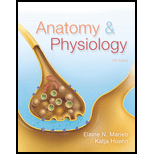
Name one organ of the alimentary canal found in the thorax. Name three organs located in the abdominal cavity.
To review:
The name of the alimentary canal organ present in the thorax region, and the three different organs that are present in the abdominal cavity.
Introduction:
The digestive organscan be categorized into two groups, namely, the alimentary canal and the accessory organs. The alimentary canal, is also referred to as the GI tract (gastrointestinal tract). It is the continuous muscular tube, extending from the mouth to the anus. It helps in digestion and absorption of food.
Explanation of Solution
Esophagus or the food pipe is the organ of the alimentary canal that is present in the thorax. The walls of the esophagus contain smooth muscles, which helps in peristaltic movement. Peristalsis is the movement caused by the alternate relaxation and contraction waves of the circulatory and longitudinal muscles, which aids in the forward movement of the food, that is, towards the stomach.
The 3 organs found in the abdominal cavity areas follows:
1. Stomach: It is a J-shaped bag-like structure, which helps in the temporary storage and mechanical distribution offood before it is movedinto the intestine. The walls of the stomach can expand or contract based on the presence of food and secreted gastric juices.
2. Small intestine: It is a long and highly coiled tube consisting of 3 regions, namely, duodenum, jejunum, and ileum. Food from the stomach is passed into the small intestine and most of the absorption process takes place in this region. The walls of the small intestine have finger-like projections, called microvilli, for the absorption of food.
3. Large intestine: It consists of 3 regions, namely, cecum, colon, and rectum. Food from the small intestine moves to this region. The absorption of water and electrolytes occurs in the large intestine and fecal matter is stored in this regionuntil it is expelled out from the body.
Therefore, it can be concluded that the esophagus (present in the thorax), stomach, small intestine, and the large intestine constitute the alimentary canal and participate in the processing and absorption of food in the body.
Want to see more full solutions like this?
Chapter 22 Solutions
Anatomy & Physiology
- What is this?arrow_forwardMolecular Biology A-C components of the question are corresponding to attached image labeled 1. D component of the question is corresponding to attached image labeled 2. For a eukaryotic mRNA, the sequences is as follows where AUGrepresents the start codon, the yellow is the Kozak sequence and (XXX) just represents any codonfor an amino acid (no stop codons here). G-cap and polyA tail are not shown A. How long is the peptide produced?B. What is the function (a sentence) of the UAA highlighted in blue?C. If the sequence highlighted in blue were changed from UAA to UAG, how would that affecttranslation? D. (1) The sequence highlighted in yellow above is moved to a new position indicated below. Howwould that affect translation? (2) How long would be the protein produced from this new mRNA? Thank youarrow_forwardMolecular Biology Question Explain why the cell doesn’t need 61 tRNAs (one for each codon). Please help. Thank youarrow_forward
- Molecular Biology You discover a disease causing mutation (indicated by the arrow) that alters splicing of its mRNA. This mutation (a base substitution in the splicing sequence) eliminates a 3’ splice site resulting in the inclusion of the second intron (I2) in the final mRNA. We are going to pretend that this intron is short having only 15 nucleotides (most introns are much longer so this is just to make things simple) with the following sequence shown below in bold. The ( ) indicate the reading frames in the exons; the included intron 2 sequences are in bold. A. Would you expected this change to be harmful? ExplainB. If you were to do gene therapy to fix this problem, briefly explain what type of gene therapy youwould use to correct this. Please help. Thank youarrow_forwardMolecular Biology Question Please help. Thank you Explain what is meant by the term “defective virus.” Explain how a defective virus is able to replicate.arrow_forwardMolecular Biology Explain why changing the codon GGG to GGA should not be harmful. Please help . Thank youarrow_forward
- Stage Percent Time in Hours Interphase .60 14.4 Prophase .20 4.8 Metaphase .10 2.4 Anaphase .06 1.44 Telophase .03 .72 Cytukinesis .01 .24 Can you summarize the results in the chart and explain which phases are faster and why the slower ones are slow?arrow_forwardCan you circle a cell in the different stages of mitosis? 1.prophase 2.metaphase 3.anaphase 4.telophase 5.cytokinesisarrow_forwardWhich microbe does not live part of its lifecycle outside humans? A. Toxoplasma gondii B. Cytomegalovirus C. Francisella tularensis D. Plasmodium falciparum explain your answer thoroughly.arrow_forward
- Select all of the following that the ablation (knockout) or ectopoic expression (gain of function) of Hox can contribute to. Another set of wings in the fruit fly, duplication of fingernails, ectopic ears in mice, excess feathers in duck/quail chimeras, and homeosis of segment 2 to jaw in Hox2a mutantsarrow_forwardSelect all of the following that changes in the MC1R gene can lead to: Changes in spots/stripes in lizards, changes in coat coloration in mice, ectopic ear formation in Siberian hamsters, and red hair in humansarrow_forwardPleiotropic genes are genes that (blank) Cause a swapping of organs/structures, are the result of duplicated sets of chromosomes, never produce protein products, and have more than one purpose/functionarrow_forward
 Human Biology (MindTap Course List)BiologyISBN:9781305112100Author:Cecie Starr, Beverly McMillanPublisher:Cengage Learning
Human Biology (MindTap Course List)BiologyISBN:9781305112100Author:Cecie Starr, Beverly McMillanPublisher:Cengage Learning Human Physiology: From Cells to Systems (MindTap ...BiologyISBN:9781285866932Author:Lauralee SherwoodPublisher:Cengage Learning
Human Physiology: From Cells to Systems (MindTap ...BiologyISBN:9781285866932Author:Lauralee SherwoodPublisher:Cengage Learning





